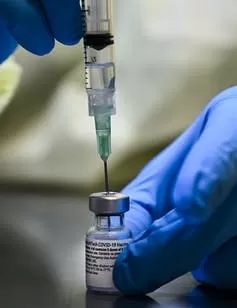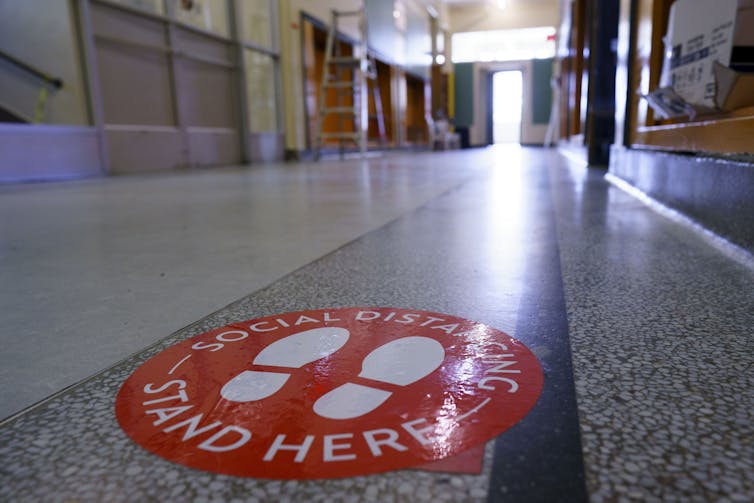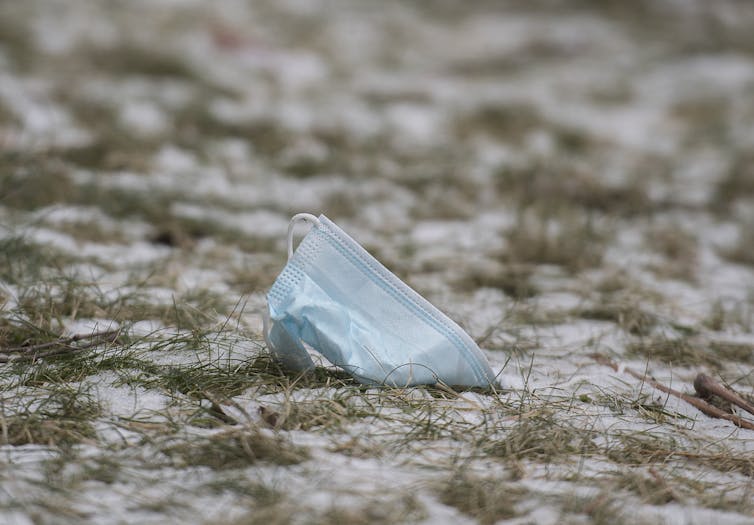Health
COVID-19 vaccine rollout: Why a mask and social distancing are still needed, even if you get the shot – The Conversation CA

It was a long struggle to adopt a new normal of wearing face masks, maintaining physical distance, handwashing and on-and-off lockdowns. Then, with the approval of two vaccines, came the expectation that the world will soon be cured of COVID-19, and that we all will resume our old normal life. But — not so fast. We must hold on to our new normal for a bit longer.
Pfizer/BioNTech and Moderna each announced in November 2020 that their mRNA-based vaccines have close to a 95 per cent efficacy rate (the efficiency with which the vaccines prevent a severe illness from COVID-19). These first vaccines were developed in record time, and also mark the first time mRNA (messenger ribonucleic acid) is being used for vaccination purposes.
However, a number of factors, such as those related to the nature of these two vaccines, our compliance with the non-pharmaceutical preventive measures (face masks, physical distancing, handwashing, isolation and quarantine) and the enormous task of vaccinating a large portion of the population, challenge our expectations of a quick end to this pandemic.
Rollout challenges
For vaccination to work and achieve herd immunity — the point at which it becomes impossible for the virus to find susceptible hosts to sustain its transmission — more than 70 per cent of the population has to be vaccinated. Dr. Anthony Fauci recently put the vaccination rate to a necessary level of 85 per cent and above!
Both vaccines face several challenges that hamper a quick vaccine rollout here in Canada and around the world, including:
- The capacity of each pharmaceutical company to produce the number of vaccine doses needed to reach 70 per cent of the population; and
- The logistics of distributing the vaccines and administering the vaccine shots far and wide.
THE CANADIAN PRESS/Nathan Denette
In addition, both Pfizer/BioNTech and Moderna vaccines require a two-dose regimen to reach the reported efficacy rate, adding to the total number of doses needed to reach herd immunity. Hence, the demand for these vaccines is bound to stress the resources and the industrial capacities of both companies.
Indeed, Pfizer early on reported challenges in meeting the production of the ordered vaccine doses, and Moderna has no record of drug production in the past, although it is working with other companies around the world to meet the production demand.
Furthermore, both vaccines require freezing temperatures for storage and distribution, making their speedy and wide distribution a challenge. These conditions are more critical in the case of the Pfizer/BioNTech vaccine; its requirement of the ultra-freezing temperature to maintain its stability makes the distribution to remote areas almost impossible. The special delivery conditions for the mRNA vaccines make the administration of the shots a nightmare in terms of the need for a large number of specialized vaccination stations and personnel.
These challenges have contributed to the low daily rate of 10 vaccination shots per 100,000 population per day in Canada in December. We need about 88,000 shots per day for the rest of 2021 to vaccinate as much as 85 per cent of the Canadian population (with a single shot). The current distribution and vaccination rates in Canada are bound to leave many high-risk population groups vulnerable to COVID-19. Hence, abiding to the current preventive measures remains paramount.
Transmission, immunity and the unvaccinated
As we celebrate the arrival of these two novel vaccines, other factors that are worth mentioning may hamper the return to our old normal life.
First, at this time, we do not have evidence that the mRNA vaccines limit the transmission of the virus.
Second, we do not know how long one remains immune to COVID-19 after being vaccinated.
Third, the population aged 16 and younger is left out of the current vaccination program due to a lack of data on safety and impact. Yet those aged 19 and younger now account for around 16 per cent of COVID-19 cases in Canada.


THE CANADIAN PRESS/Graham Hughes
On the other hand, there is a real risk that with the current vaccine rollout there will be an increase in transmission contacts due to the perception of vaccine-acquired immunity and the notion that vaccination will prevent transmission. Continued compliance with the non-pharmaceutical preventive measures is essential, especially when many are experiencing COVID-19 fatigue and most people have gotten used to the idea that other diseases can be stopped with a single pill or shot.
Indeed, the continuous spread of COVID-19 in Canada shows that many do not comply with the preventive measures and lockdown guidelines. The percentage of people who test positive for COVID-19, called the positivity rate, is now at 4.3 per cent.


THE CANADIAN PRESS/Paul Chiasson
A recent mathematical model evaluated the impact of vaccine efficacy and coverage in preventing future COVID-19 outbreaks. It predicts a possible increased risk of outbreaks during the vaccination of the population. This preliminary study, called a preprint, has yet to be “peer reviewed,” formally vetted by other scientists.
The predicted risk was based on the assumption that a person who believed they were immune might increase their potential transmission contacts through increased social and economic activities, as well as through lack of compliance with pharmaceutical preventive measures such as masks and social distancing.
The study showed that the risk of outbreaks depends on the efficacy rate and coverage of the vaccines, and the compliance with the non-pharmaceutical prevention measures. It predicts an increase in the size of the outbreak when vaccination coverage is high, the vaccine efficacy is low and the compliance with masks, social distancing and other non-pharmaceutical prevention measures is low.
Canada and many other countries are contemplating a single dose vaccination regimen to reach as many people as quickly as they can with the doses that they have in hand. However, the single dose mRNA vaccine efficacy rate is much lower than two doses: about 50 per cent to 70 per cent.
Under these high coverage/low vaccine efficacy conditions, continued public education about the potential risks of not complying with non-pharmaceutical preventive measures, in the midst of a pandemic and a challenging en masse vaccine rollout, is crucial to keep the COVID-19 spread under control.
Is there an end?


THE CANADIAN PRESS/Graham Hughes
The approval of the two mRNA vaccines and the start of vaccination of high-risk population groups in Canada certainly has made the light at the end of the tunnel seem brighter. However, until most of the population gets vaccinated with vaccines of high efficacy, compliance with the non-pharmaceutical prevention measures remains critical to curb the spread of COVID-19 and save lives. We must be patient with the vaccine’s effect on herd immunity and persist with preventive practices even when the current lockdowns end and our economy reopens.
Health
RCMP warn about benzodiazepine-laced fentanyl tied to overdose in Alberta – Edmonton Journal


Article content
Grande Prairie RCMP issued a warning Friday after it was revealed fentanyl linked to a deadly overdose was mixed with a chemical that doesn’t respond to naloxone treatment.
The drugs were initially seized on Feb. 28 after a fatal overdose, and this week, Health Canada reported back to Mounties that the fentanyl had been mixed with Bromazolam, which is a benzodiazepine.
Article content
Mounties say this is the first recorded instance of Bromazolam in Alberta. The drug has previously been linked to nine fatal overdoses in New Brunswick in 2022.
The pills seized in Alberta were oval-shaped and stamped with “20” and “SS,” though Mounties say it can come in other forms.
Naloxone treatment, given in many cases of opioid toxicity, is not effective in reversing the effects of Bromazalam, Mounties said, and therefore, any fentanyl mixed with the benzodiazepine “would see a reduced effectiveness of naloxone, requiring the use of additional doses and may still result in a fatality.”
From January to November of last year, there were 1,706 opioid-related deaths in Alberta, and 57 linked to benzodiazepine, up from 1,375 and 43, respectively, in 2022.
Mounties say officers responded to about 1,100 opioid-related calls for service, last year with a third of those proving fatal. RCMP officers also used naloxone 67 times while in the field, a jump of nearly a third over the previous year.
Recommended from Editorial
Share this article in your social network
Health
CFIA continues surveillance for HPAI in cattle, while sticking with original name for disease – RealAgriculture


The Canada Food Inspection Agency will continue to refer to highly pathogenic avian influenza in cattle as HPAI in cattle, and not refer to it as bovine influenza A virus (BIAV), as suggested by the American Association of Bovine Practitioners earlier this month.
Dr. Martin Appelt, senior director for the Canadian Food Inspection Agency, in the interview below, says at this time Canada will stick with “HPAI in cattle” when referencing the disease that’s been confirmed in dairy cattle in multiple states in the U.S.
The CFIA’s naming policy is consistent with the agency’s U.S. counterparts’, as the U.S. Animal and Plant Health Inspection Service has also said it will continue referring to it as HPAI or H5N1.
Appelt explains how the CFIA is learning from the U.S. experience to-date, and how it is working with veterinarians across Canada to stay vigilant for signs of the disease in dairy and beef cattle.
As of April 19, there has not been a confirmed case of HPAI in cattle in Canada. Appelt says it’s too soon to say if an eventual positive case will significantly restrict animal movement, as is the case with positive poultry cases.
This is a major concern for the cattle industry, as beef cattle especially move north and south across the U.S. border by the thousands. Appelt says that CFIA will address an infection in each species differently in conjunction with how the disease is spread and the threat to neighbouring farms or livestock.
Currently, provincial dairy organizations have advised producers to postpone any non-essential tours of dairy barns, as a precaution, in addition to other biosecurity measures to reduce the risk of cattle contracting HPAI.
Subscribe: Apple Podcasts | Spotify | RSS | All Podcasts
jQuery(document).ready(function($) {
$(“#homesub”).validate(
rules:
first_name:
required: true,
minlength: 2
,
last_name:
required: true,
minlength: 2
,
email:
required: true,
email: true,
minlength: 2
,
state:
required: true,
,
role:
required: true,
,
“listid[]”:
required: true,
minlength: 1
,
messages:
first_name: “Your first name is required.”,
last_name: “Your last name is required.”,
email: “Please verify your email is correct.”,
state: “Your state/province is required.”,
role: “Your role is required.”,
“listid[]”: “Select at least one list is required.”
,
submitHandler: function()
$.ajax(
type: “POST”,
url: “https://www.realagriculture.com/wp-admin/admin-ajax.php”,
data:
action: “realag_cc_process_subscribe_onclick”,
form: “homesub”,
data: $(“#homesub”).serialize(),
,
dataType: “html”,
timeout: 30000,
error: function(response)
console.log(response);
,
success: function(response)
$(“#homesub”).html(response);
,
);
);
});
Health
Toronto reports 2 more measles cases. Use our tool to check the spread in Canada – Toronto Star


/* OOVVUU Targeting */
const path = ‘/news/canada’;
const siteName = ‘thestar.com’;
let domain = ‘thestar.com’;
if (siteName === ‘thestar.com’)
domain = ‘thestar.com’;
else if (siteName === ‘niagarafallsreview.ca’)
domain = ‘niagara_falls_review’;
else if (siteName === ‘stcatharinesstandard.ca’)
domain = ‘st_catharines_standard’;
else if (siteName === ‘thepeterboroughexaminer.com’)
domain = ‘the_peterborough_examiner’;
else if (siteName === ‘therecord.com’)
domain = ‘the_record’;
else if (siteName === ‘thespec.com’)
domain = ‘the_spec’;
else if (siteName === ‘wellandtribune.ca’)
domain = ‘welland_tribune’;
else if (siteName === ‘bramptonguardian.com’)
domain = ‘brampton_guardian’;
else if (siteName === ‘caledonenterprise.com’)
domain = ‘caledon_enterprise’;
else if (siteName === ‘cambridgetimes.ca’)
domain = ‘cambridge_times’;
else if (siteName === ‘durhamregion.com’)
domain = ‘durham_region’;
else if (siteName === ‘guelphmercury.com’)
domain = ‘guelph_mercury’;
else if (siteName === ‘insidehalton.com’)
domain = ‘inside_halton’;
else if (siteName === ‘insideottawavalley.com’)
domain = ‘inside_ottawa_valley’;
else if (siteName === ‘mississauga.com’)
domain = ‘mississauga’;
else if (siteName === ‘muskokaregion.com’)
domain = ‘muskoka_region’;
else if (siteName === ‘newhamburgindependent.ca’)
domain = ‘new_hamburg_independent’;
else if (siteName === ‘niagarathisweek.com’)
domain = ‘niagara_this_week’;
else if (siteName === ‘northbaynipissing.com’)
domain = ‘north_bay_nipissing’;
else if (siteName === ‘northumberlandnews.com’)
domain = ‘northumberland_news’;
else if (siteName === ‘orangeville.com’)
domain = ‘orangeville’;
else if (siteName === ‘ourwindsor.ca’)
domain = ‘our_windsor’;
else if (siteName === ‘parrysound.com’)
domain = ‘parrysound’;
else if (siteName === ‘simcoe.com’)
domain = ‘simcoe’;
else if (siteName === ‘theifp.ca’)
domain = ‘the_ifp’;
else if (siteName === ‘waterloochronicle.ca’)
domain = ‘waterloo_chronicle’;
else if (siteName === ‘yorkregion.com’)
domain = ‘york_region’;
let sectionTag = ”;
try
if (domain === ‘thestar.com’ && path.indexOf(‘wires/’) = 0)
sectionTag = ‘/business’;
else if (path.indexOf(‘/autos’) >= 0)
sectionTag = ‘/autos’;
else if (path.indexOf(‘/entertainment’) >= 0)
sectionTag = ‘/entertainment’;
else if (path.indexOf(‘/life’) >= 0)
sectionTag = ‘/life’;
else if (path.indexOf(‘/news’) >= 0)
sectionTag = ‘/news’;
else if (path.indexOf(‘/politics’) >= 0)
sectionTag = ‘/politics’;
else if (path.indexOf(‘/sports’) >= 0)
sectionTag = ‘/sports’;
else if (path.indexOf(‘/opinion’) >= 0)
sectionTag = ‘/opinion’;
} catch (ex)
const descriptionUrl = ‘window.location.href’;
const vid = ‘mediainfo.reference_id’;
const cmsId = ‘2665777’;
let url = `https://pubads.g.doubleclick.net/gampad/ads?iu=/58580620/$domain/video/oovvuu$sectionTag&description_url=$descriptionUrl&vid=$vid&cmsid=$cmsId&tfcd=0&npa=0&sz=640×480&ad_rule=0&gdfp_req=1&output=vast&unviewed_position_start=1&env=vp&impl=s&correlator=`;
url = url.split(‘ ‘).join(”);
window.oovvuuReplacementAdServerURL = url;
Canada has seen a concerning rise in measles cases in the first months of 2024.
By the third week of March, the country had already recorded more than three times the number of cases as all of last year. Canada had just 12 cases of measles in 2023, up from three in 2022.
function buildUserSwitchAccountsForm()
var form = document.getElementById(‘user-local-logout-form-switch-accounts’);
if (form) return;
// build form with javascript since having a form element here breaks the payment modal.
var switchForm = document.createElement(‘form’);
switchForm.setAttribute(‘id’,’user-local-logout-form-switch-accounts’);
switchForm.setAttribute(‘method’,’post’);
switchForm.setAttribute(‘action’,’https://www.thestar.com/tncms/auth/logout/?return=https://www.thestar.com/users/login/?referer_url=https%3A%2F%2Fwww.thestar.com%2Fnews%2Fcanada%2Ftoronto-reports-2-more-measles-cases-use-our-tool-to-check-the-spread-in-canada%2Farticle_20aa7df4-e88f-11ee-8fad-8f8368d7ff53.html’);
switchForm.setAttribute(‘style’,’display:none;’);
var refUrl = document.createElement(‘input’); //input element, text
refUrl.setAttribute(‘type’,’hidden’);
refUrl.setAttribute(‘name’,’referer_url’);
refUrl.setAttribute(‘value’,’https://www.thestar.com/news/canada/toronto-reports-2-more-measles-cases-use-our-tool-to-check-the-spread-in-canada/article_20aa7df4-e88f-11ee-8fad-8f8368d7ff53.html’);
var submit = document.createElement(‘input’);
submit.setAttribute(‘type’,’submit’);
submit.setAttribute(‘name’,’logout’);
submit.setAttribute(‘value’,’Logout’);
switchForm.appendChild(refUrl);
switchForm.appendChild(submit);
document.getElementsByTagName(‘body’)[0].appendChild(switchForm);
function handleUserSwitchAccounts()
window.sessionStorage.removeItem(‘bd-viafoura-oidc’); // clear viafoura JWT token
// logout user before sending them to login page via return url
document.getElementById(‘user-local-logout-form-switch-accounts’).submit();
return false;
buildUserSwitchAccountsForm();
#ont-map-iframepadding:0;width:100%;border:0;overflow:hidden;
#ontario-cases-iframepadding:0;width:100%;border:0;overflow:hidden;
#province-table-iframepadding:0;width:100%;border:0;overflow:hidden;
console.log(‘=====> bRemoveLastParagraph: ‘,0);
-
Media14 hours ago
DJT Stock Rises. Trump Media CEO Alleges Potential Market Manipulation. – Barron's
-
Media16 hours ago
Trump Media alerts Nasdaq to potential market manipulation from 'naked' short selling of DJT stock – CNBC
-
Investment15 hours ago
Private equity gears up for potential National Football League investments – Financial Times
-



 Sports19 hours ago
Sports19 hours ago2024 Stanley Cup Playoffs 1st-round schedule – NHL.com
-



 Investment24 hours ago
Investment24 hours agoWant to Outperform 88% of Professional Fund Managers? Buy This 1 Investment and Hold It Forever. – The Motley Fool
-



 Health23 hours ago
Health23 hours agoToronto reports 2 more measles cases. Use our tool to check the spread in Canada – Toronto Star
-
Business15 hours ago
Gas prices see 'largest single-day jump since early 2022': En-Pro International – Yahoo Canada Finance
-
Real eState7 hours ago
Botched home sale costs Winnipeg man his right to sell real estate in Manitoba – CBC.ca






